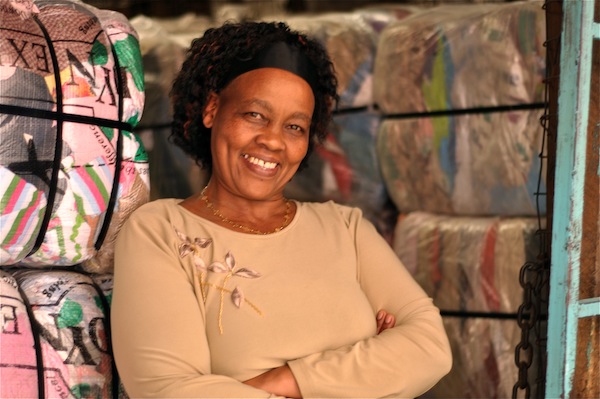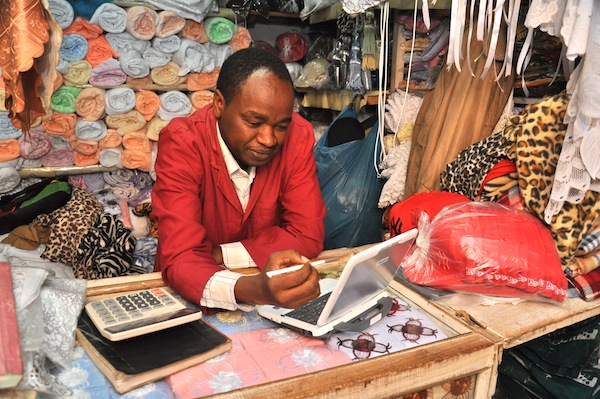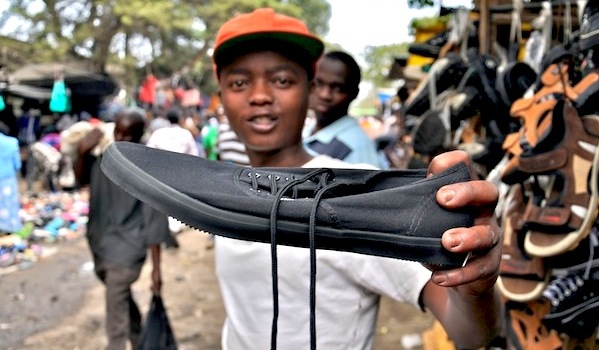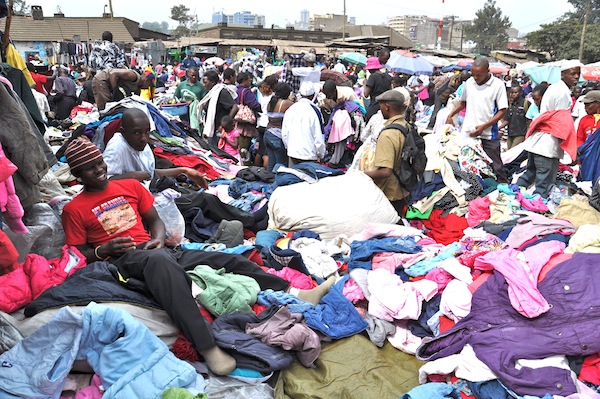If you want to learn a thing or two about business, just ask Leah Mugure Mwaura. Leah is a charming Kenyan grandmother and owner of a clothing wholesale business in Gikomba, a sprawling, dusty, crowded place on the outskirts of Nairobi that is now East Africa’s largest market. Every day, tens of thousands of Kenyans show up to trade in Gikomba’s maze of wooden stalls, buying and selling everything from mangos, okra, fish, and poultry to shoes, radios, hammers, and rugs. But Gikomba’s main industry is mutumba, Kiswahili for secondhand clothes. Tons upon tons of the stuff arrive every week after being cast away by charities like Goodwill and the Salvation Army. Mutumba is a multimillion dollar industry for Africa, and in Gikomba, it is a challenging but fertile opportunity for Kenyans with a little entrepreneurial spirit.
In 1991, Leah spent all her savings—the equivalent of about USD $180—on a shrink-wrapped bag of used T-shirts, jeans, blouses, and skirts, with the simple goal of turning those wrinkled clothes into profit. In her early years, she’d arrive in Gikomba at 5:30 a.m. with a shoulder-slung sack of mutumba and spend long, hot hours hawking her wares in the vast, open-air flea market. Jostling for space in the throng, Leah would shout out prices for her small pile of clothes as shoppers picked through massive heaps of shirts, mounds of trousers, and pastel rivers of secondhand lingerie—Gikomba’s biggest seller, according to Leah.
For nineteen years, Leah built her business from the ground up, without any help. She never even opened a bank account. “I was running it by myself, with my own money,” she recalls. “Little by little, I saved.” But building the business was slow going, and after a certain point, her sales plateaued. In a highly active market like Gikomba, growth is all about volume: the customers are plentiful, and your sales are limited only by how much merchandise you have on hand. But in order to grow her volume, Leah needed to scale up her business. For that, she needed capital.

Leah Mugure Mwaura, a wholesale mutumba dealer in Nairobi’s Gikomba Market, spent twenty years building her business without any help from banks.
Every few years, a microfinance agency would come to Gikomba and offer Leah a small loan, perhaps $500 or $1,000. Microfinance was intended to help the poor, but Leah didn’t feel that it was for her. The agencies had a lot of terms and conditions. To qualify, Leah would have to join a group of other borrowers, and if one of them defaulted on their payments, they would all suffer. And besides, Leah needed larger sums of money. By that time she already had a thriving wholesale shop, housed in a warehouse of rusty iron sheets near the center of Gikomba. To really boost her business, Leah would have needed five or six times the amount that the microfinance institutions were able to offer. A bank loan would have helped, but the thought never even crossed Leah’s mind. “Banks were for the big people,” she explains.
In a country like Kenya, where credit reports essentially don’t exist, the banks enforce a seemingly draconian system of lending requirements. For most loans, you have to put up 100 percent collateral. If you do not have enough cash—and small business owners like Leah rarely do—the bank will come to your home to value your assets, from your car to your refrigerator; if you ever default on the loan, these possessions become subject to requisition. On top of collateral, you have to find a co-guarantor who agrees to reimburse the bank in the event of default and a lawyer to process your loan application and financial statements. Banks maintain that they must use such controls to weed out dishonest borrowers—the people looking for so-called hakuna matata loans, because they take the money and run. But as a result, most small businesses are locked out. “It’s like a mountain ahead of you!” Leah says. “People fear banks. The banks are not for us little people.”
Thousands of shopkeepers in Gikomba, and millions of other small businesses in the developing world, face this challenge. These individuals are good businesspeople; many of them are brilliant entrepreneurs. They understand how a profit margin works, they know how to track turnover and costs, they know their supply chains. They know they have strong businesses, and they know what they need to grow. But they can’t get the right financing.
It’s a catch-22: these small and medium-sized enterprises (often called SMEs) are too big for microfinance, but they lack the collateral and credit history required by banks. Research shows that small businesses have incredible growth potential and high returns to capital. It also shows that banks want to invest in small businesses but too often do not because of the lack of information and the unknown risk. This leads to a “missing middle” in developing countries: lots of microenterprises at the low end of the economy, some giant firms at the top, and then a swath of small entrepreneurs who exist in this limbo, above the poverty line but unable to grow.
Needles in the Haystack
In 2010, two researchers from the John F. Kennedy School of Government at Harvard University started a social enterprise to address the problem of funding SMEs. The Entrepreneurial Finance Lab, or EFL, began as a research project for Bailey Klinger, a PhD student at the school, and Kennedy School Professor of Public Policy Asim Khwaja, an expert in development finance. Recognizing the dearth of credit-scoring and risk-assessment tools in developing countries, Klinger and Khwaja set about to build a solution: a credit-scoring test for the developing world. If finding creditworthy business owners is like trying to find a needle in a haystack, then EFL aims to be the metal detector.
The EFL tool is basically a questionnaire that measures an entrepreneur’s risk and potential. Based on research about the common characteristics of successful entrepreneurs, the EFL application considers traits like drive, intelligence, attitude, outlook, ability, and character, as well as the entrepreneur’s business acumen and quantitative skills. While it is not a personality test per se, the EFL test applies basic psychometric principles to the analytic process of credit scoring as a way to measure individuals’ potential and to predict the risk of giving them a loan.
Klinger and Khwaja designed the tool over six years and have administered it more than 25,000 times in eighteen countries and eleven different languages. EFL uses this data to continuously fine-tune the model—to finesse out inaccurate questions, calibrate for each country’s context and culture, and make sure the questions are complex enough that applicants cannot game the system. At the beginning, there were hundreds of questions, and the test took two or three hours to complete. After years of tweaking and throwing out irrelevant questions, the current EFL test, which includes multiple-choice and true-false questions, as well as math problems, takes an entrepreneur about thirty minutes to complete. Individuals can do it in the local bank branch or on a small netbook laptop in the comfort of their own shop.
Some find it difficult to believe that a thirty-minute questionnaire could predict so much about an entrepreneur. But the EFL application does not test for specific traits themselves; it tests for the symptoms of those traits. Business virtues like honesty and trustworthiness would be impossible to measure analytically, but there are certain skills, behaviors, and attitudes commonly shared by most honest and trustworthy business owners. EFL tests for evidence of these behaviors and attitudes; it asks questions directly related to an entrepreneur’s ability to succeed in business and the likelihood that the individual would repay a loan.
Many questions require the entrepreneurs to make calculations in their head; some ask about their knowledge of competitors’ prices and products and about their budget estimates for future sales; other questions are more values-based. Typical questions might read:
* How do you calculate the profit margin of your main products?
* Do you think there are limits to the future opportunities of your business?
* Do you feel like your life has direction?
* Is it possible for an average employee to be honest 100 percent of the time?
On their own, individual questions seem basic, but combined, they provide EFL with a rich portrait of entrepreneurial potential. Measured against thousands of other applicants in a market like Gikomba, EFL can identify the top-tier entrepreneurs with the highest potential and the lowest risk and then recommend them to the bank for a loan.
In 2010, Klinger and Khwaja teamed up with Harvard Business School alumnus and entrepreneur DJ DiDonna and started selling the tool to banks in Africa, Latin America, and the Middle East. At first, the banks were skeptical. How could a thirty-minute test identify a creditworthy businessperson? But over time and several field studies, EFL generated impressive results. Research showed that banks using the EFL application as a screening tool could reduce the typical default rate on comparable SME bank loans by 20 percent to 45 percent. Finally, EFL secured its first customer: Standard Bank, the largest bank in Africa.

Munga Kimata, owner of a retail shop for general goods in the Kamukunji area of Gikomba. After taking the EFL application, he was given a loan of 1 million Kenyan shillings (the equivalent of $12,000 USD), which allowed him to double his stock and expand his business.
A Business Boost
In November 2010, Leah learned about the new loan program that Standard Bank was rolling out in Gikomba. It sounded like a fantastic deal: all you had to do was take a thirty-minute quiz and you could get a loan with no collateral requirements, no guarantor, and no need for a lawyer. Leah simply thought, “Why not?’”
She remembers it being a strange test. “The questions were all about honesty,” she recollects. “If I borrow money from a stranger, will I repay it?” Two days after taking the EFL questionnaire, the bank approved Leah for a first-time loan of 600,000 Kenyan shillings, or the equivalent of about USD $7,000.
“I felt so excited and happy,” she says. She used the loan to expand her stock. She bought fifty bales of clothes—more than she’d ever purchased before—and the larger stock attracted more and more customers. Business boomed, and she upgraded to a new and bigger warehouse. She paid back the bank loan in full, ahead of her schedule. “It felt beautiful,” she recalls.
A year later, in response to her growth and the good standing of her account, the bank preapproved her for a new loan of two million shillings, or USD $24,000. After receiving this inflow of capital, her profits tripled: “I moved from point A to point B,” she says. “Maybe even point C or D. I’m proud.”
For twenty years, Leah had never even opened a bank account. Now in a short fourteen months, she had received $31,000 in capital loans.
A Path to the Middle
Leah’s experience is no anomaly. In fact, more than 3,500 traders in Gikomba have now received no-strings-attached loans like Leah’s. Within the proverbial haystack, it turns out, there are thousands of needles waiting to be found.
Gikomba was the pilot project of EFL’s partnership with Standard Bank to administer 100,000 tests to SMEs all across Africa. With an average loan size of $7,500, that’s a potential for $750 million in loans to unbanked or under-banked African business owners who would otherwise be rejected. The tool is currently being used in Kenya, South Africa, Nigeria, Ghana, Tanzania, and Zambia; by summer 2012 it will have expanded to Malawi, Botswana, and Lesotho; then it will roll out in Mozambique, Uganda, and Namibia. EFL is readying pilot projects in Pakistan, India, Saudi Arabia, and Egypt. Next year, it will expand to Southeast Asia.
To give a sense of how much lending this entails, this year, Standard Bank aims to lend approximately $5 million every single week using the EFL tool.
There are, like with any development initiative, some important drawbacks to consider. Even with the EFL test, some borrowers are still defaulting. There are still hakuna matata loans. Since EFL does not administer the test itself, there is no way to know how Standard Bank manages the test-taking environment or if people are trying to cheat or getting help on the questions. From the borrowers’ perspective, the interest rates, which are in the double digits, are high by some measures. And if an entrepreneur is predicted by EFL to be too risky, he or she could be disqualified from further consideration.
But another way to look at it is that EFL has allowed Standard Bank to reach thousands of traders in Gikomba that it previously never had access to. Before EFL, a typical commercial bank never would have even looked at loan applications for SMEs like Leah. The EFL tool is giving banks unprecedented access to a portion of the market that has largely been ignored.
After fourteen months of operation, the results have been staggeringly positive. Business owners across Africa have benefitted from more than $60 million in loans that allow them to grow their businesses and contribute to their economies. Meanwhile, Standard Bank benefits from thousands of new customers in an untapped market, customers who also often sign up for other bank products, from home loans to credit cards.
Today, Leah is one of the most successful wholesale clothing suppliers in Gikomba. “Business is hard,” she says while sitting on a bale of mutumba in her rusty warehouse, as rays of sunlight sneak through the walls. “Competition is fierce. Many have tried and failed. But business is good, so long as you are hardworking and honest. Honesty is better than having ten million in your pocket; without trust, your business will collapse.”
Last year Leah built her own house, and she’s putting her granddaughters Rosie and Faith through private school in downtown Nairobi. She is a rising member of Kenya’s growing middle class—a segment of society often overlooked by aid agencies, nongovernmental organizations, and microfinance institutions that focus on the very poor. While microfinance is sometimes seen as a trickle-up development strategy—addressing poverty as one of the causes of hunger, disease, or lack of education—SME finance is a driver for growth and economic development.
Leah’s story is universal. Globally, there are an estimated 400 million unbanked SMEs that fall into the financing gap. These overlooked entrepreneurs represent a new market for a new type of development.
EFL aims to unleash entrepreneurial potential, helping small business owners like Leah demonstrate their best qualities and their capacity to grow. Starting in Gikomba and scaling globally, EFL’s cheap and simple tool sets a mighty promise: to unlock chains of growth and to start filling the missing middle.
This article was originally published in the 2012 edition of the Kennedy School Review.
Photos courtesy of author.


